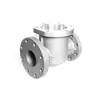Mobile:+86-311-808-126-83
Email:info@ydcastings.com
Optimizing Engine Performance with Exhaust and Intake Manifold Design Techniques
Understanding the Exhaust and Intake Manifold Key Components of Engine Performance
In the complex world of internal combustion engines, the efficiency and performance are significantly influenced by various components. Among these, the exhaust and intake manifolds play crucial roles. Understanding how these components work can enhance our comprehension of engine dynamics and optimization.
The Basics What Are Manifolds?
Manifolds are critical pieces of automotive engineering that serve as connectors between various engine components. Specifically, the intake manifold is designed to distribute the air-fuel mixture to the engine cylinders, while the exhaust manifold collects the exhaust gases from the cylinders and directs them out of the engine. The effectiveness of these manifolds directly impacts an engine's performance, efficiency, and emissions.
The Intake Manifold
The intake manifold is primarily responsible for delivering the air-fuel mixture from the throttle body to the individual cylinders of the engine. Its design can significantly affect an engine's power delivery, throttle response, and fuel efficiency. For instance, the length and diameter of the intake runners—the passages that lead to the cylinders—are designed to optimize the airflow and maintain proper pressure levels throughout the system.
A well-designed intake manifold can enhance volumetric efficiency, allowing more air and fuel to enter the cylinders. Increased airflow means that more fuel can be burned more efficiently, leading to more power output. Manufacturers frequently experiment with different manifold designs, including variable intake manifolds that alter configuration based on engine speed and load, providing the best possible performance across a broad operational range.
The Exhaust Manifold
exhaust intake manifold

The exhaust manifold, on the other hand, has the critical task of expelling the exhaust gases produced during combustion. After fuel combusts in the engine's cylinders, a mix of gases—primarily nitrogen, carbon dioxide, and unburned hydrocarbons—must be expelled to make room for the next cycle of air and fuel.
An efficient exhaust manifold reduces back pressure—resistance to outflow—which allows exhaust gases to exit the engine more quickly. This quicker expulsion minimizes the energy lost in the exhaust process, allowing for more energy to be used for power generation during the intake phase. Performance exhaust manifolds often feature smoother bends and larger diameters to facilitate better gas flow, significantly impacting the overall power and efficiency of the engine.
The Interplay Between Intake and Exhaust Manifolds
The interaction between the intake and exhaust manifolds is crucial for overall engine performance. A well-tuned balance between these components is essential for achieving optimal combustion efficiency. When the exhaust system is too restrictive, it can create back pressure, leading to a decrease in power output. Conversely, if the intake system is not designed to manage airflow effectively, it can lead to poor air-fuel distribution, resulting in incomplete combustion and reduced efficiency.
The technology involved in designing these manifolds has evolved significantly over the years. Modern engines use advanced materials and manufacturing techniques, such as composite materials and CNC machining, to ensure precision and performance. Additionally, advanced engine management systems can optimize manifold operation, adjusting to varying conditions for maximum efficiency.
Conclusion Importance of Manifold Optimization
In conclusion, the exhaust and intake manifolds are integral components that can make or break an engine's performance. Their design, material, and engineering directly influence the efficiency, power, and emissions of an internal combustion engine. As automotive technology progresses towards electric and hybrid systems, the importance of optimizing these traditional components remains critical for improving fuel economy and minimizing emissions in gasoline and diesel engines.
Understanding the relationship between these manifolds not only helps manufacturers improve engine design but also allows automotive enthusiasts to make informed modifications to enhance performance. Whether you're an engineer, a mechanic, or a car enthusiast, recognizing the vital roles of the exhaust and intake manifolds is essential for appreciating the intricacies of engine performance.
-
Why Should You Invest in Superior Pump Castings for Your Equipment?NewsJun.09,2025
-
Unlock Performance Potential with Stainless Impellers and Aluminum End CapsNewsJun.09,2025
-
Revolutionize Your Machinery with Superior Cast Iron and Aluminum ComponentsNewsJun.09,2025
-
Revolutionize Fluid Dynamics with Premium Pump ComponentsNewsJun.09,2025
-
Optimizing Industrial Systems with Essential Valve ComponentsNewsJun.09,2025
-
Elevate Grid Efficiency with High-Precision Power CastingsNewsJun.09,2025











